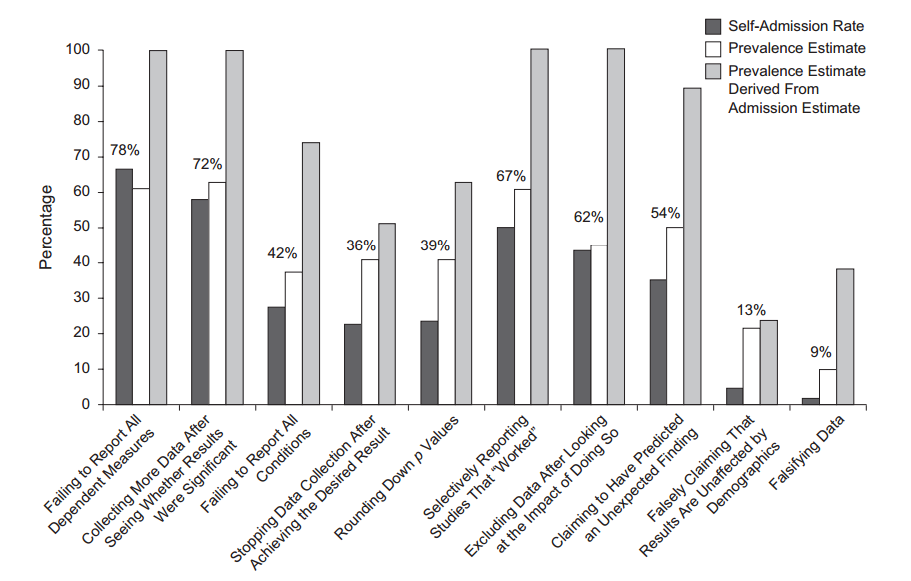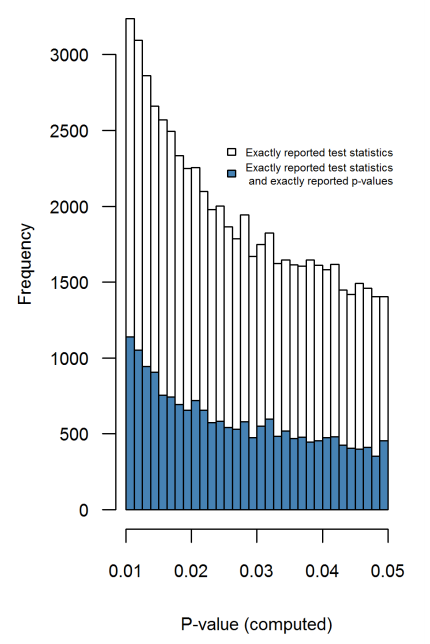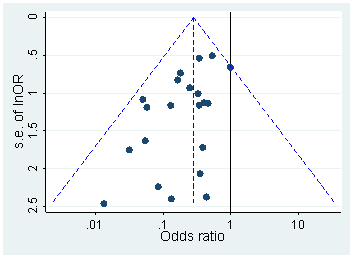EXECUTIVE SUMMARY: if "p-hacking" is to be understood broadly a la Gelman's forking paths, the answer to how prevalent it is, is that it is almost universal.
Andrew Gelman likes to write about this topic and has been posting extensively about it lately on his blog. I don't always agree with him but I like his perspective on $p$-hacking. Here is an excerpt from the Introduction to his Garden of Forking Paths paper (Gelman & Loken 2013; a version appeared in American Scientist 2014; see also Gelman's brief comment on the ASA's statement), emphasis mine:
This problem is sometimes called “p-hacking” or “researcher degrees of freedom” (Simmons, Nelson,
and Simonsohn, 2011). In a recent article, we spoke of “fishing expeditions [...]”. But we are starting to feel that the term “fishing” was unfortunate, in that it invokes an image
of a researcher trying out comparison after comparison, throwing the line into the lake repeatedly
until a fish is snagged. We have no reason to think that researchers regularly do that. We think
the real story is that researchers can perform a reasonable analysis given their assumptions and
their data, but had the data turned out differently, they could have done other analyses that were
just as reasonable in those circumstances.
We regret the spread of the terms “fishing” and “p-hacking” (and even “researcher degrees of
freedom”) for two reasons: first, because when such terms are used to describe a study, there is
the misleading implication that researchers were consciously trying out many different analyses
on a single data set; and, second, because it can lead researchers who know they did not try
out many different analyses to mistakenly think they are not so strongly subject to problems of
researcher degrees of freedom. [...]
Our key point here is that it is possible to have multiple potential comparisons, in the sense of
a data analysis whose details are highly contingent on data, without the researcher performing any
conscious procedure of fishing or examining multiple p-values.
So: Gelman does not like the term p-hacking because it implies that the researches were actively cheating. Whereas the problems can occur simply because the researchers choose what test to perform/report after looking at the data, i.e. after doing some exploratory analysis.
With some experience of working in biology, I can safely say that everybody does that. Everybody (myself included) collects some data with only vague a priori hypotheses, does extensive exploratory analysis, runs various significance tests, collects some more data, runs and re-runs the tests, and finally reports some $p$-values in the final manuscript. All of this is happening without actively cheating, doing dumb xkcd-jelly-beans-style cherry-picking, or consciously hacking anything.
So if "p-hacking" is to be understood broadly a la Gelman's forking paths, the answer to how prevalent it is, is that it is almost universal.
The only exceptions that come to mind are fully pre-registered replication studies in psychology or fully pre-registered medical trials.
Specific evidence
Amusingly, some people polled researchers to find that many admit doing some sort of hacking (John et al. 2012, Measuring the Prevalence of Questionable
Research Practices With Incentives for
Truth Telling):

Apart from that, everybody heard about the so called "replication crisis" in psychology: more than one half of the recent studies published in the top psychology journals do not replicate (Nosek et al. 2015, Estimating the reproducibility of psychological science). (This study has recently been all over the blogs again, because the March 2016 issue of Science published a Comment attempting to refute Nosek et al. and also a reply by Nosek et al. The discussion continued elsewhere, see post by Andrew Gelman and the RetractionWatch post that he links to. To put it politely, the critique is unconvincing.)
Update Nov 2018: Kaplan and Irvin, 2017, Likelihood of Null Effects of Large NHLBI Clinical Trials Has Increased over Time show that the fraction of clinical trials reporting null results increased from 43% to 92% after pre-registration became required:

$P$-value distributions in the literature
Head et al. 2015
I have not heard about Head et al. study before, but have now spent some time looking through the surrounding literature. I have also taken a brief look at their raw data.
Head et al. downloaded all Open Access papers from PubMed and extracted all p-values reported in the text, getting 2.7 mln p-values. Out of these, 1.1 mln was reported as $p=a$ and not as $p<a$. Out of these, Head et al. randomly took one p-value per paper but this does not seem to change the distribution, so here is how the distribution of all 1.1 mln values looks like (between $0$ and $0.06$):

I used $0.0001$ bin width, and one can clearly see a lot of predictable rounding in the reported $p$-values. Now, Head et al. do the following: they compare the number of $p$-values in the $(0.045, 0.5)$ interval and in the $(0.04, 0.045)$ interval; the former number turns out to be (significantly) larger and they take it as an evidence of $p$-hacking. If one squints, one can see it on my figure.
I find this hugely unconvincing for one simple reason. Who wants to report their findings with $p=0.05$? Actually, many people seem to be doing exactly that, but still it appears natural to try to avoid this unsatisfactory border-line value and rather to report another significant digit, e.g. $p=0.048$ (unless of course it's $p=0.052$). So some excess of $p$-values close but not equal to $0.05$ can be explained by researcher's rounding preferences.
And apart from that, the effect is tiny.
(The only strong effect that I can see on this figure is a pronounced drop of the $p$-value density right after $0.05$. This is clearly due to the publication bias.)
Unless I missed something, Head et al. do not even discuss this potential alternative explanation. They do not present any histogram of the $p$-values either.
There is a bunch of papers criticizing Head et al. In this unpublished manuscript Hartgerink argues that Head et al. should have included $p=0.04$ and $p=0.05$ in their comparison (and if they had, they would not have found their effect). I am not sure about that; it does not sound very convincing. It would be much better if we could somehow inspect the distribution of the "raw" $p$-values without any rounding.
Distributions of $p$-values without rounding
In this 2016 PeerJ paper (preprint posted in 2015) the same Hartgerink et al. extract p-values from lots of papers in top psychology journals and do exactly that: they recompute exact $p$-values from the reported $t$-, $F$-, $\chi^2$- etc. statistic values; this distribution is free from any rounding artifacts and does not exhibit any increase towards 0.05 whatsoever (Figure 4):
$\hspace{5em}$
A very similar approach is taken by Krawczyk 2015 in PLoS One, who extracts 135k $p$-values from the top experimental psychology journals. Here is how the distribution looks for the reported (left) and recomputed (right) $p$-values:

The difference is striking. The left histogram shows some weird stuff going on around $p=0.05$, but on the right one it is gone. This means that this weird stuff is due to people's preferences of reporting values around $p\approx 0.05$ and not due to $p$-hacking.
Mascicampo and Lalande
It seems that the first to observe the alleged excess of $p$-values just below 0.05 were Masicampo & Lalande 2012, looking at three top journals in psychology:

This does look impressive, but Lakens 2015 (preprint) in a published Comment argues that this only appears impressive thanks to the misleading exponential fit. See also Lakens 2015, On the challenges of drawing conclusions from p-values just below 0.05 and references therein.
Economics
Brodeur et al. 2016 (the link goes to the 2013 preprint) do the same thing for economics literature. The look at the three economics journals, extract 50k test results, convert all of them into $z$-scores (using reported coefficients and standard errors whenever possible and using $p$-values if only they were reported), and get the following:

This is a bit confusing because small $p$-values are on the right and large $p$-values are on the left. As authors write in the abstract, "The distribution of p-values exhibits a camel shape with abundant p-values above .25" and "a valley between .25 and .10". They argue that this valley is a sign of something fishy, but this is only an indirect evidence. Also, it might be simply due to selective reporting, when large p-values above .25 are reported as some evidence of a lack of effect but p-values between .1 and .25 are felt to be neither here nor there and tend to be omitted. (I am not sure if this effect is present in biological literature or not because the plots above focus on $p<0.05$ interval.)
Falsely reassuring?
Based on all of the above, my conclusion is that I don't see any strong evidence of $p$-hacking in $p$-value distributions across biological/psychological literature as a whole. There is plenty of evidence of selective reporting, publication bias, rounding $p$-values down to $0.05$ and other funny rounding effects, but I disagree with conclusions of Head et al.: there is no suspicious bump below $0.05$.
Uri Simonsohn argues that this is "falsely reassuring". Well, actually he cites these papers un-critically but then remarks that "most p-values are way smaller" than 0.05. Then he says: "That’s reassuring, but falsely reassuring". And here is why:
If we want to know if researchers p-hack their results, we need to examine the p-values associated with their results, those they may want to p-hack in the first place. Samples, to be unbiased, must only include observations from the population of interest.
Most p-values reported in most papers are irrelevant for the strategic behavior of interest. Covariates, manipulation checks, main effects in studies testing interactions, etc. Including them we underestimate p-hacking and we overestimate the evidential value of data. Analyzing all p-values asks a different question, a less sensible one. Instead of “Do researchers p-hack what they study?” we ask “Do researchers p-hack everything?”
This makes total sense. Looking at all reported $p$-values is way too noisy. Uri's $p$-curve paper (Simonsohn et al. 2013) nicely demonstrates what one can see if one looks at carefully selected $p$-values. They selected 20 psychology papers based on some suspicious keywords (namely, authors of these papers reported tests controlling for a covariate and did not report what happens without controlling for it) and then took only $p$-values that are testing the main findings. Here is how the distribution looks like (left):

Strong left skew suggests strong $p$-hacking.
Conclusions
I would say that we know that there must be a lot of $p$-hacking going on, mostly of the Forking-Paths type that Gelman describes; probably to the extent that published $p$-values cannot really be taken at face value and should be "discounted" by the reader by some substantial fraction. However, this attitude seems to produce much more subtle effects than simply a bump in the overall $p$-values distribution just below $0.05$ and cannot really be detected by such a blunt analysis.











